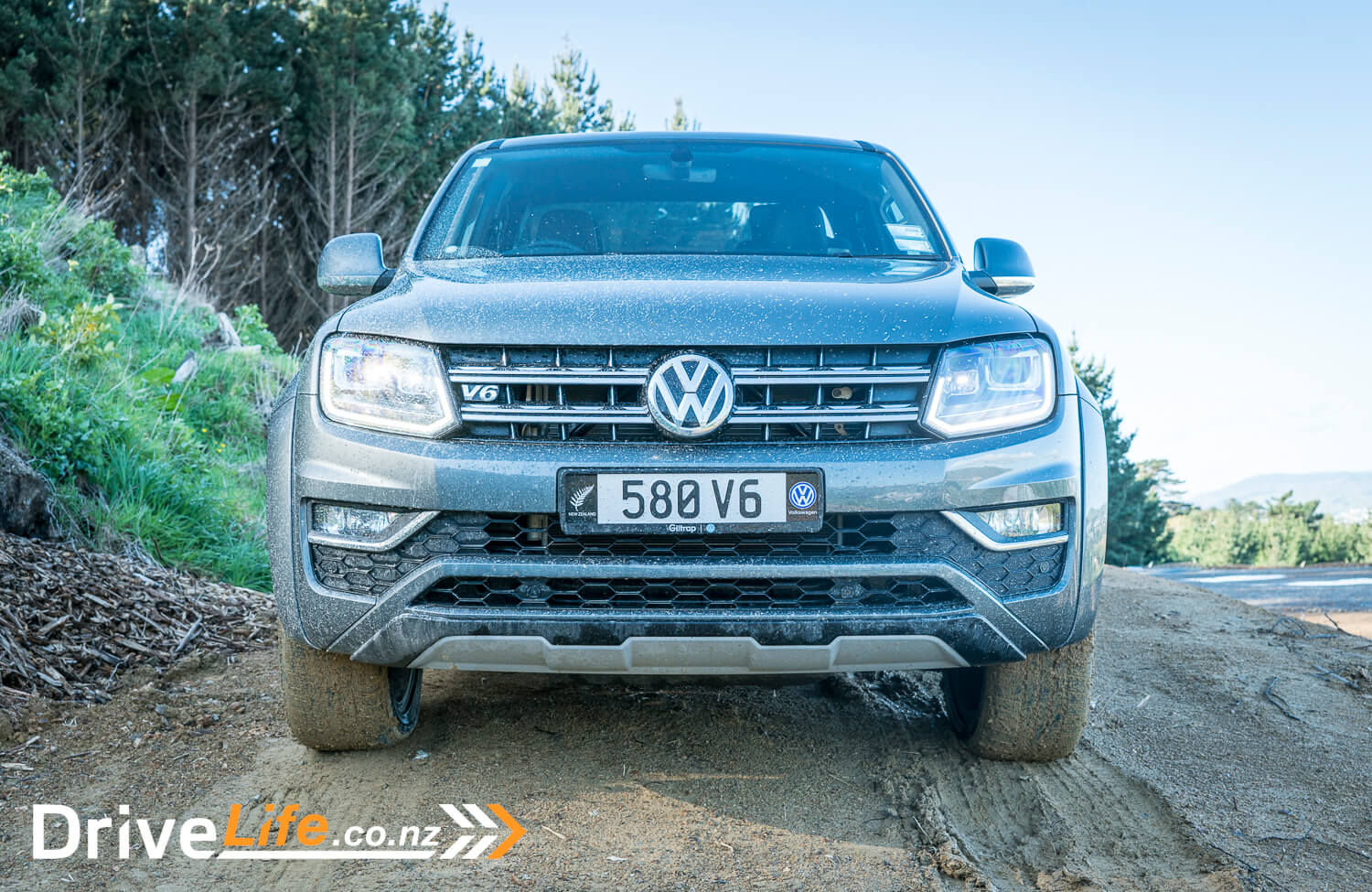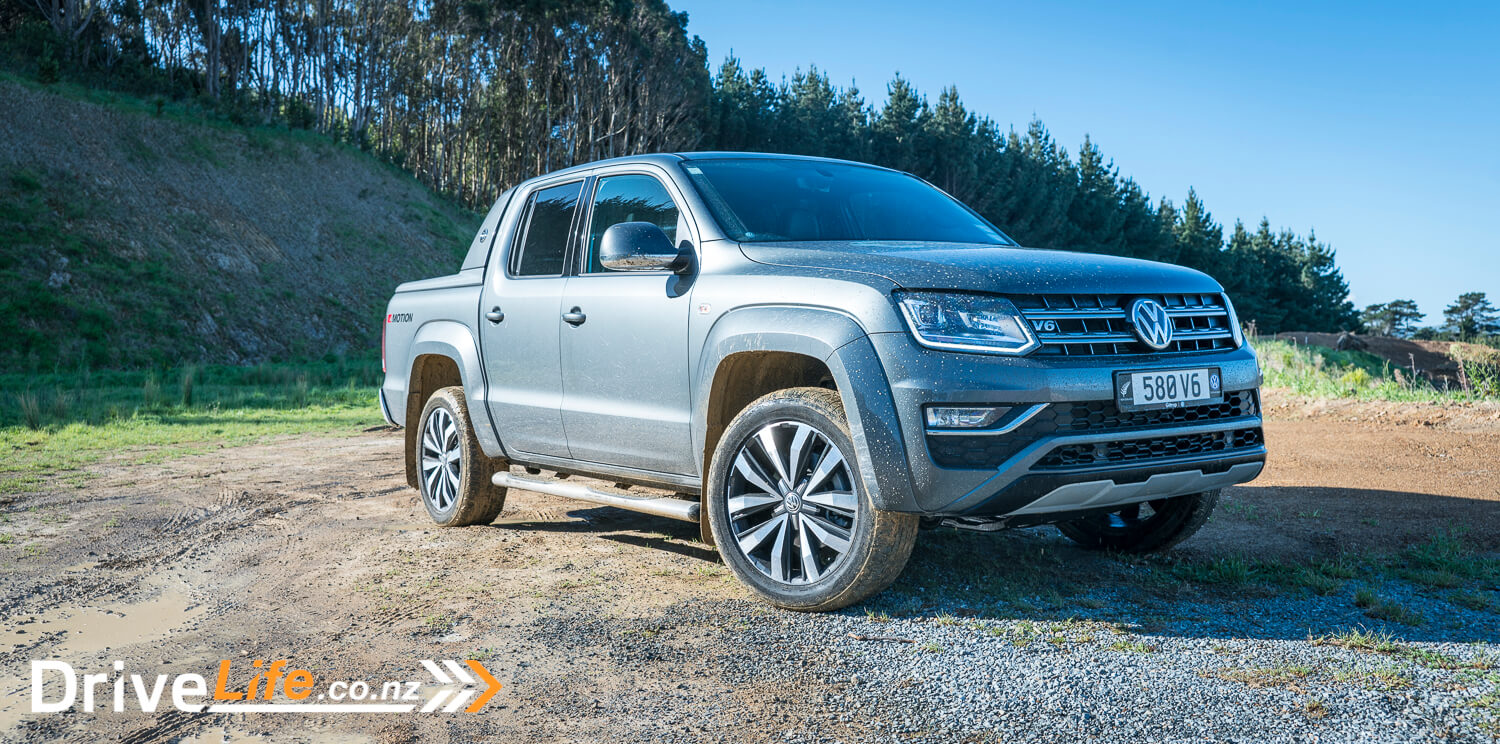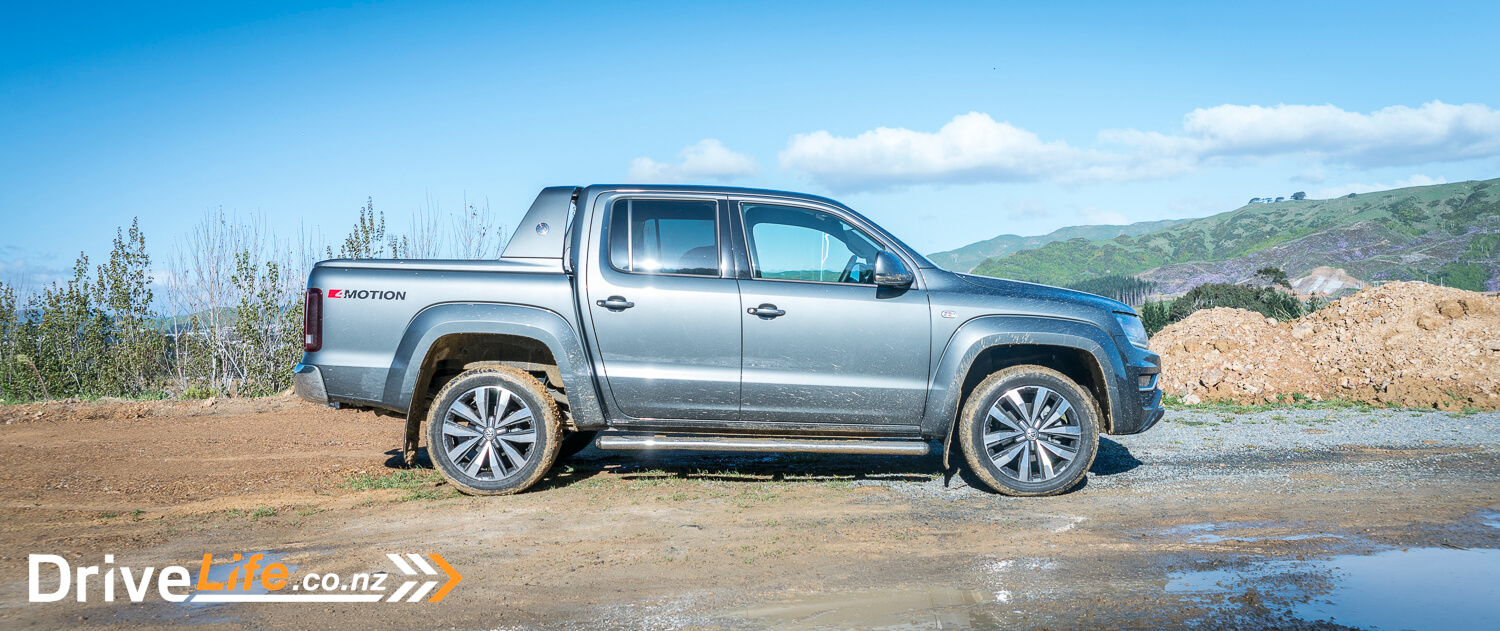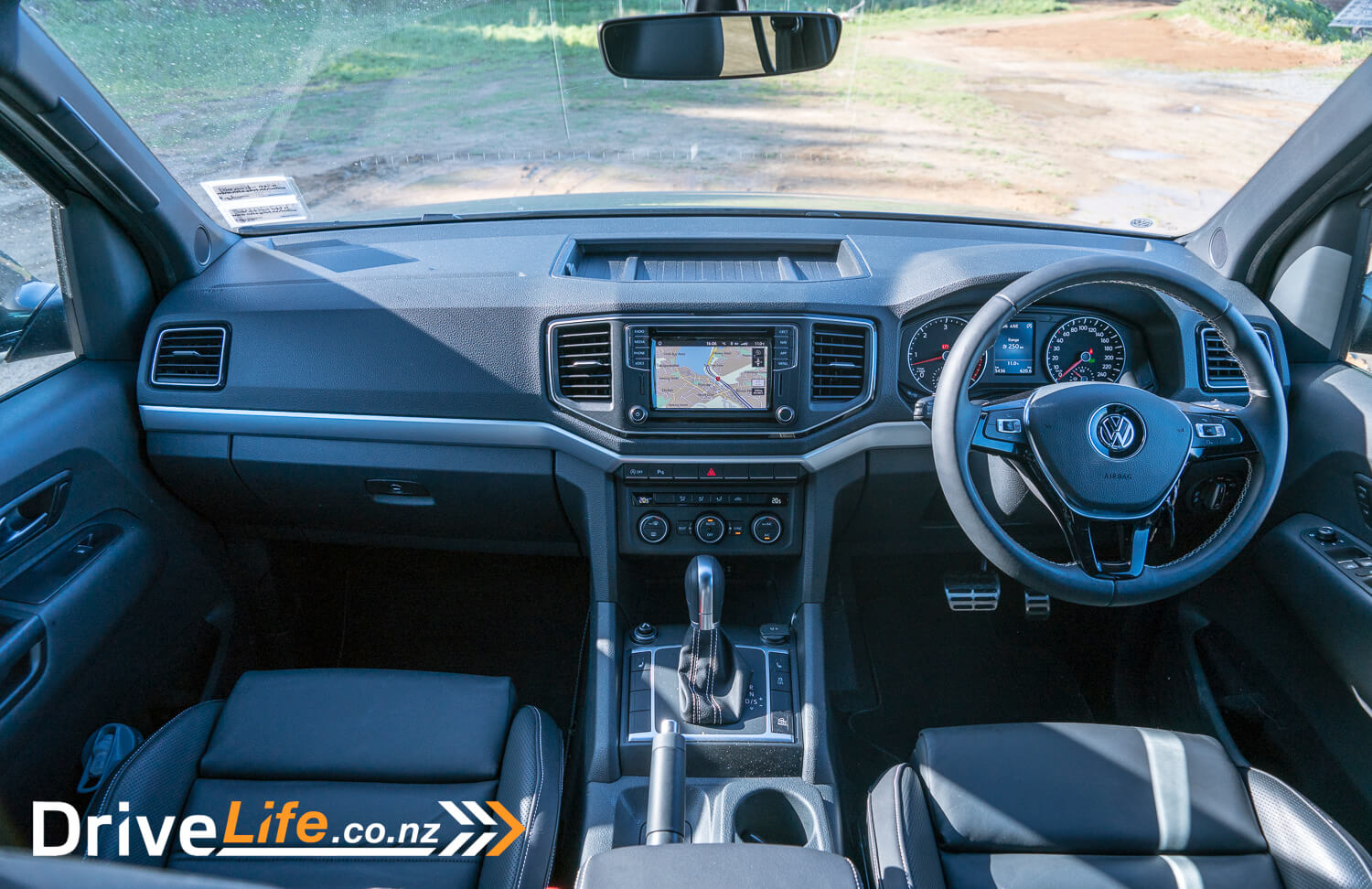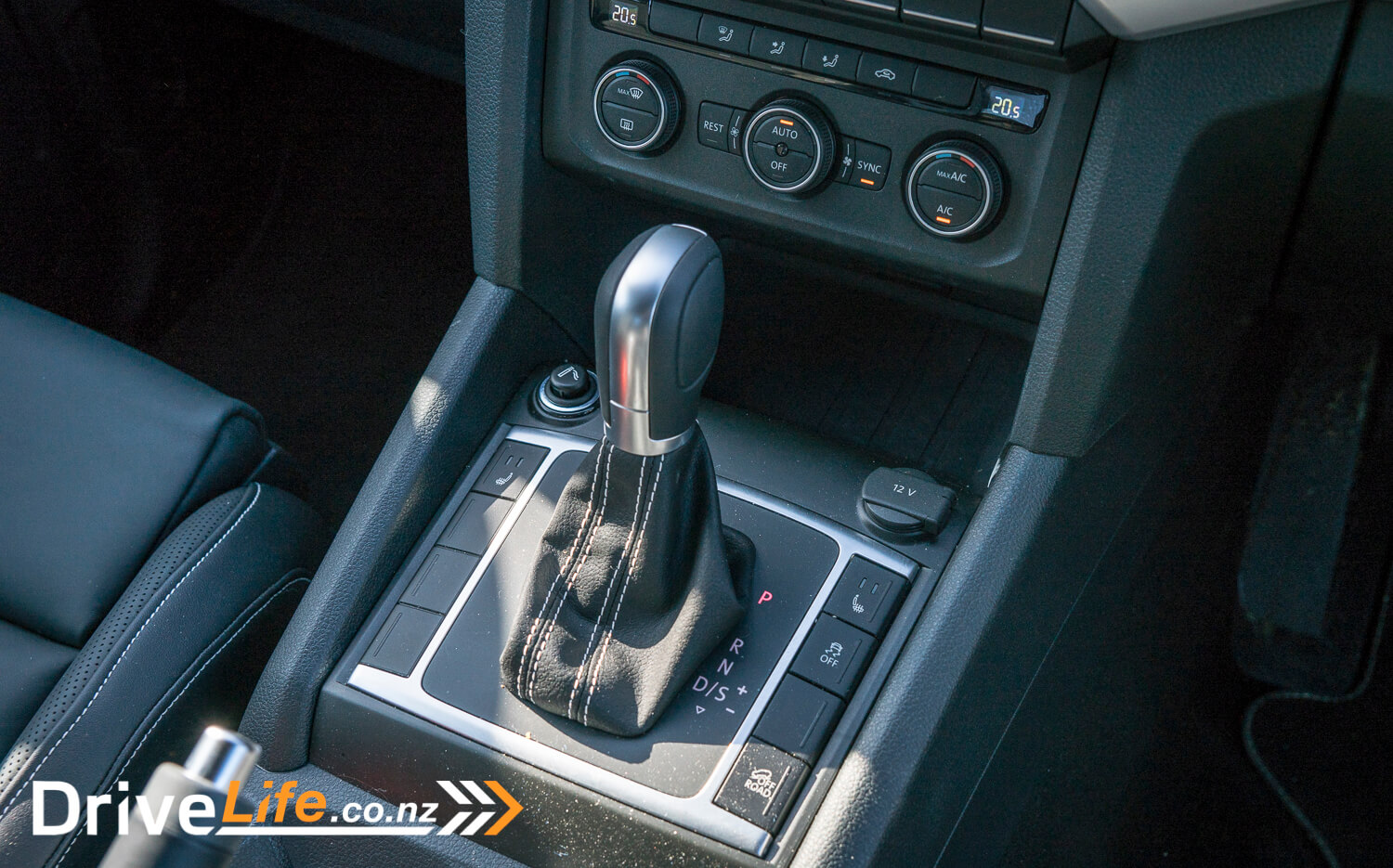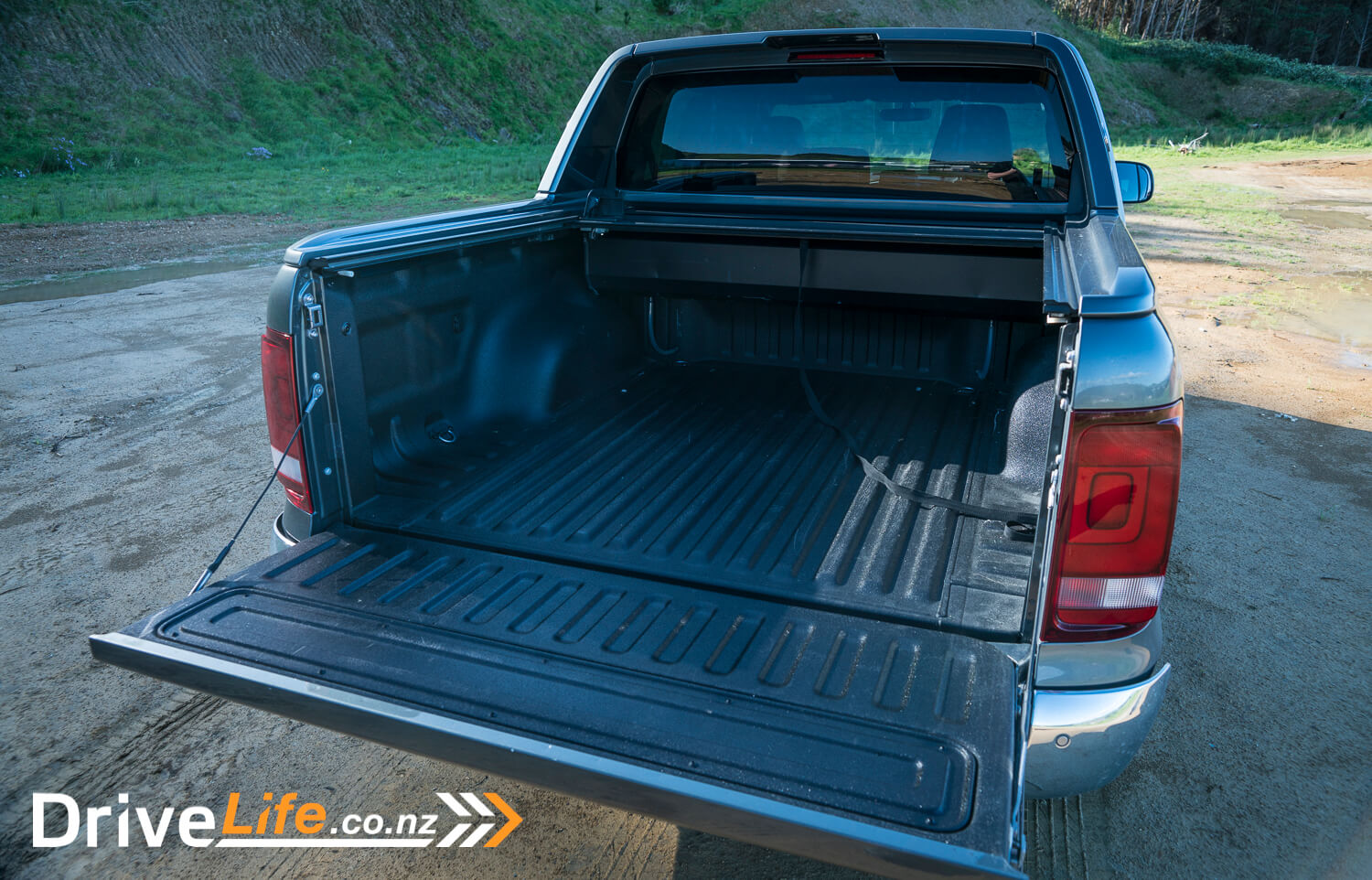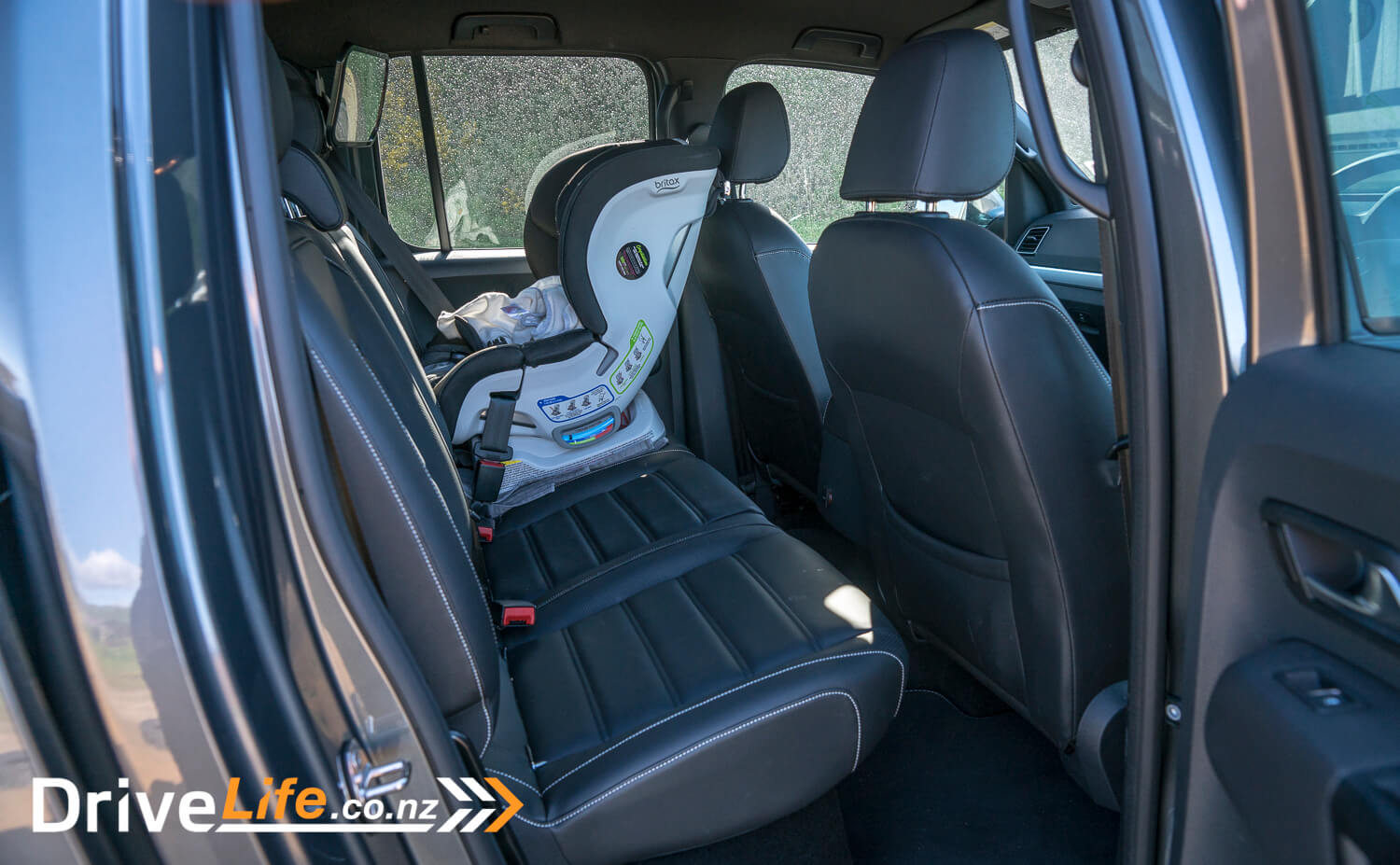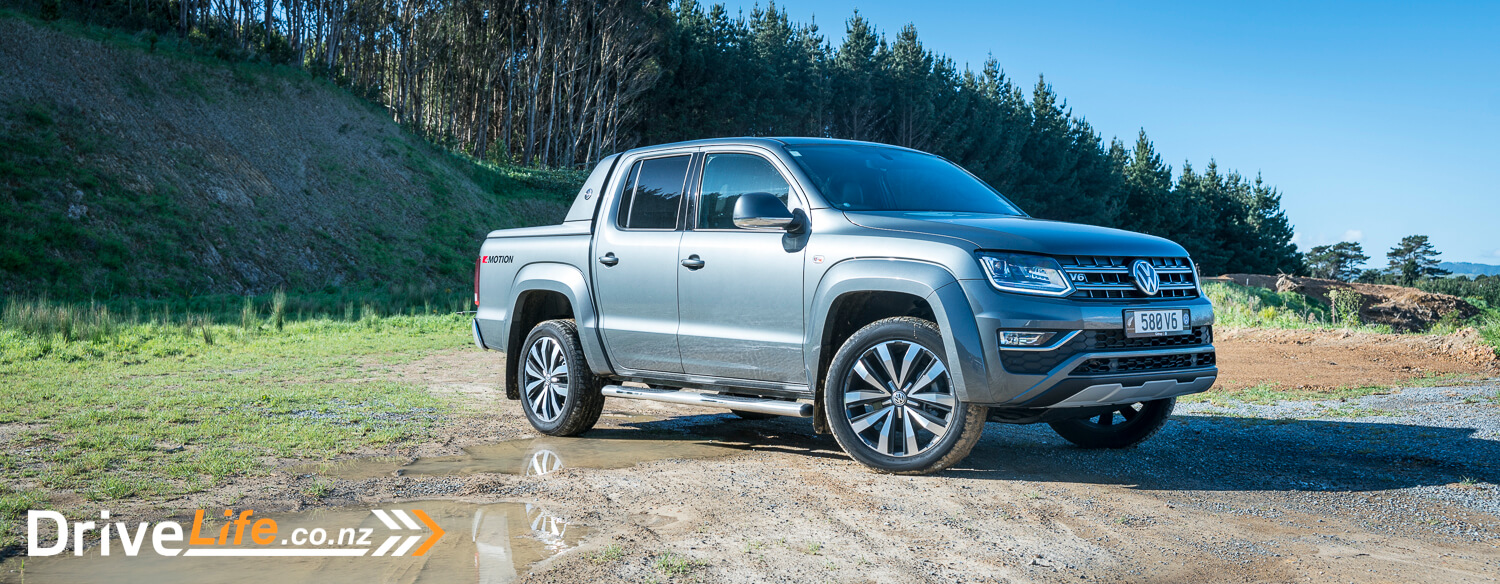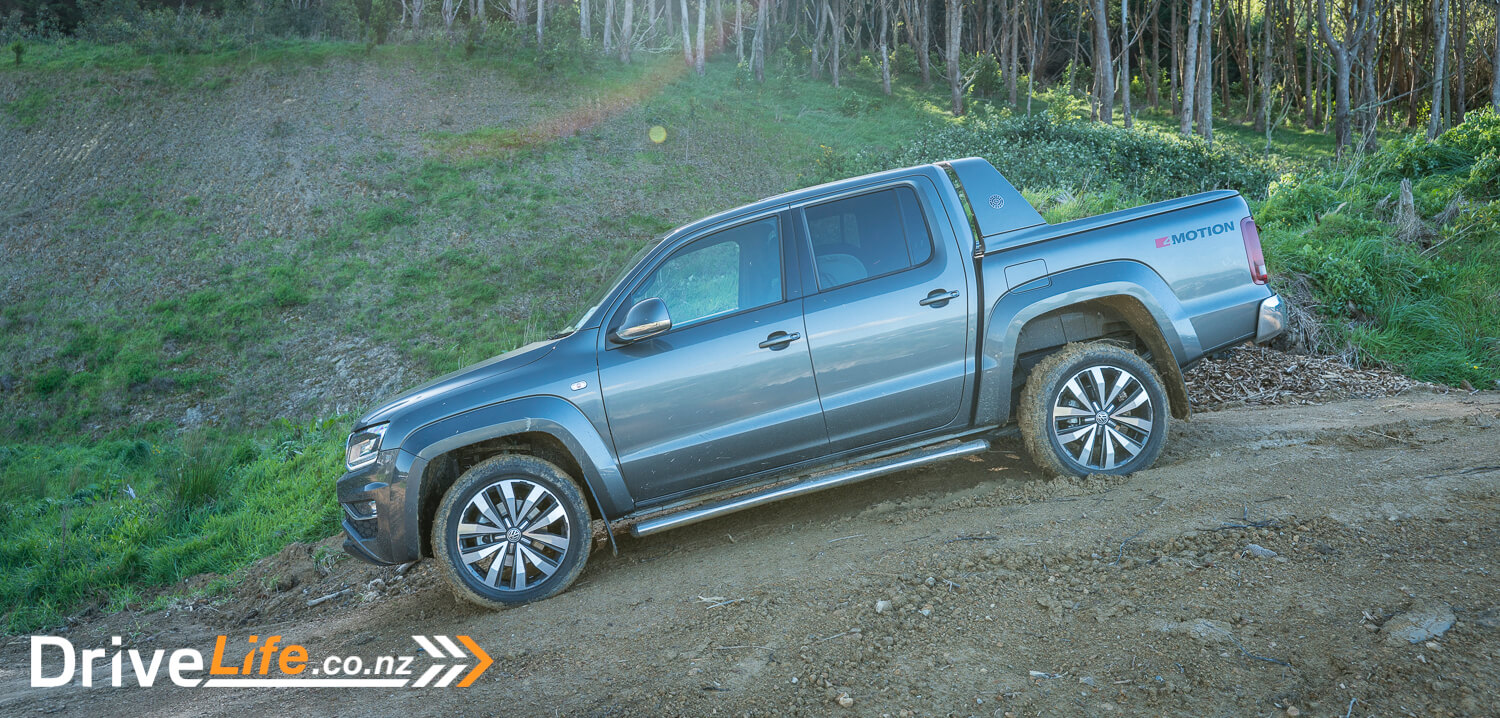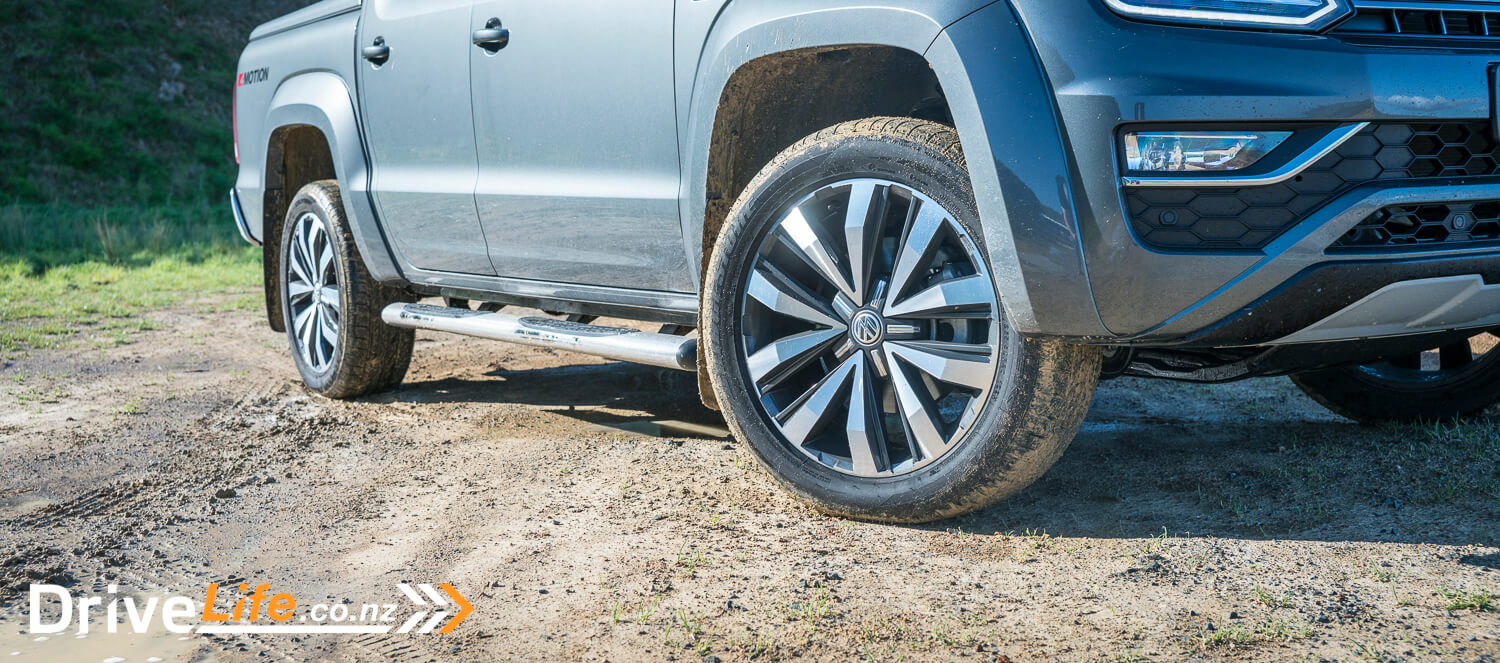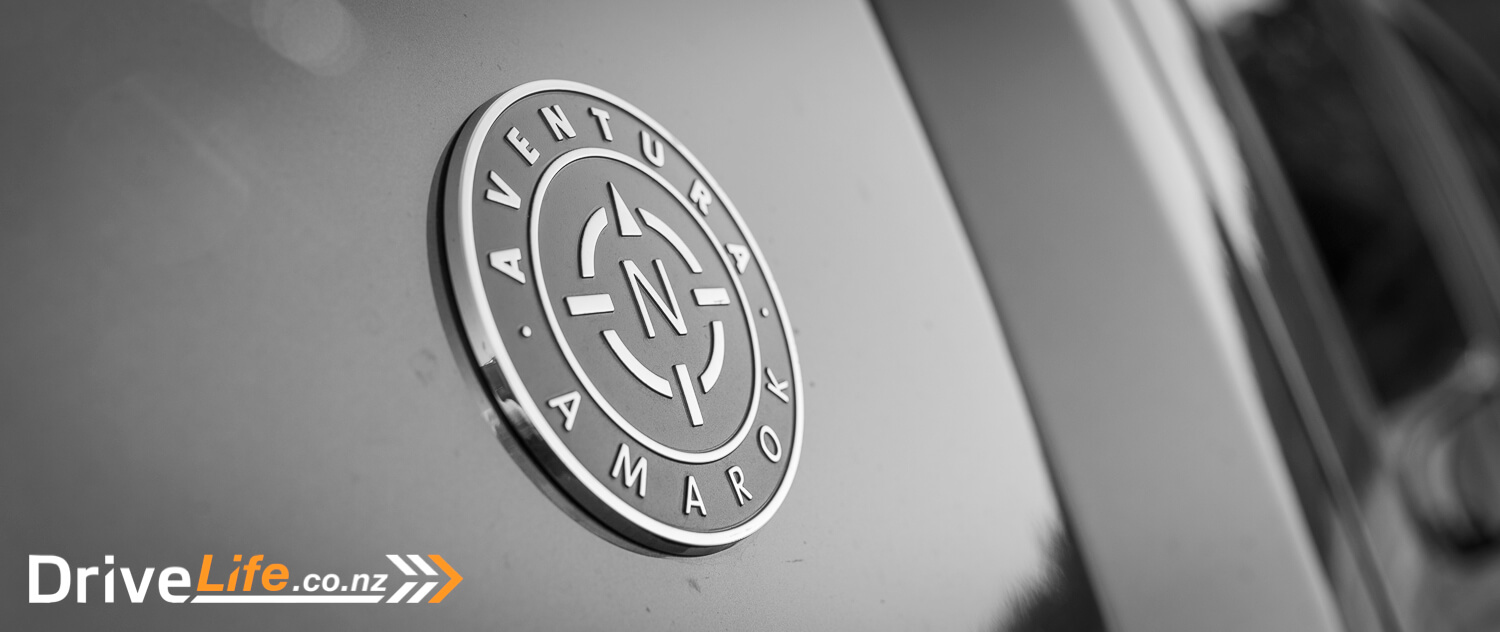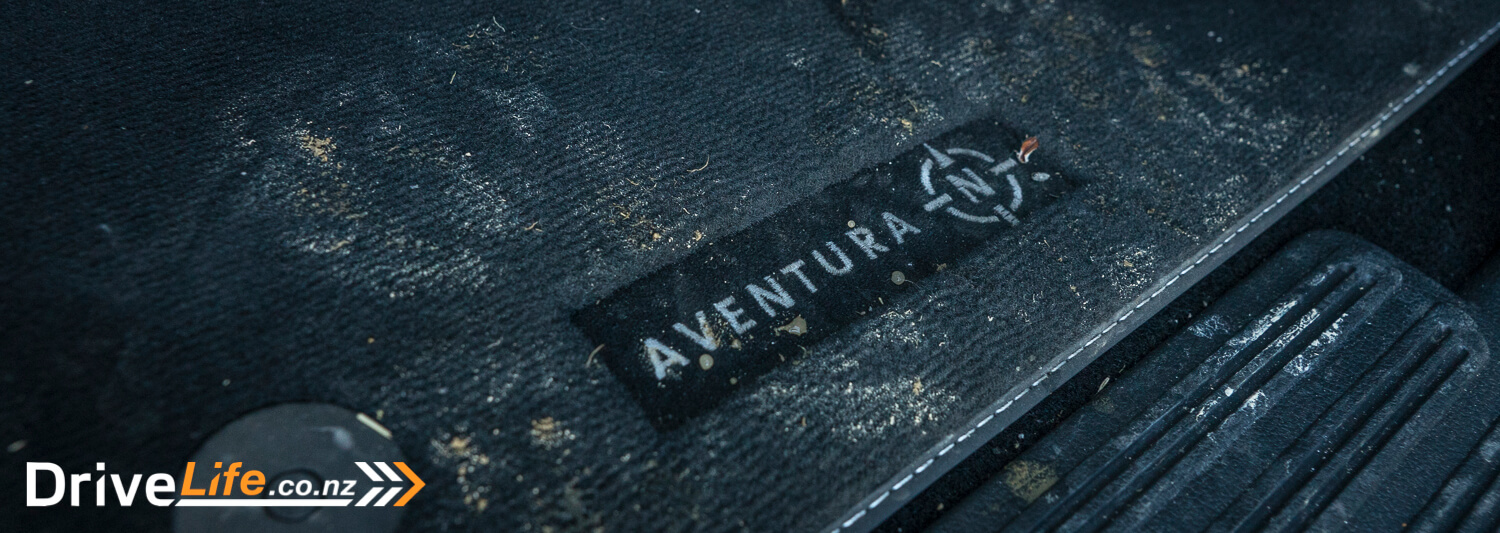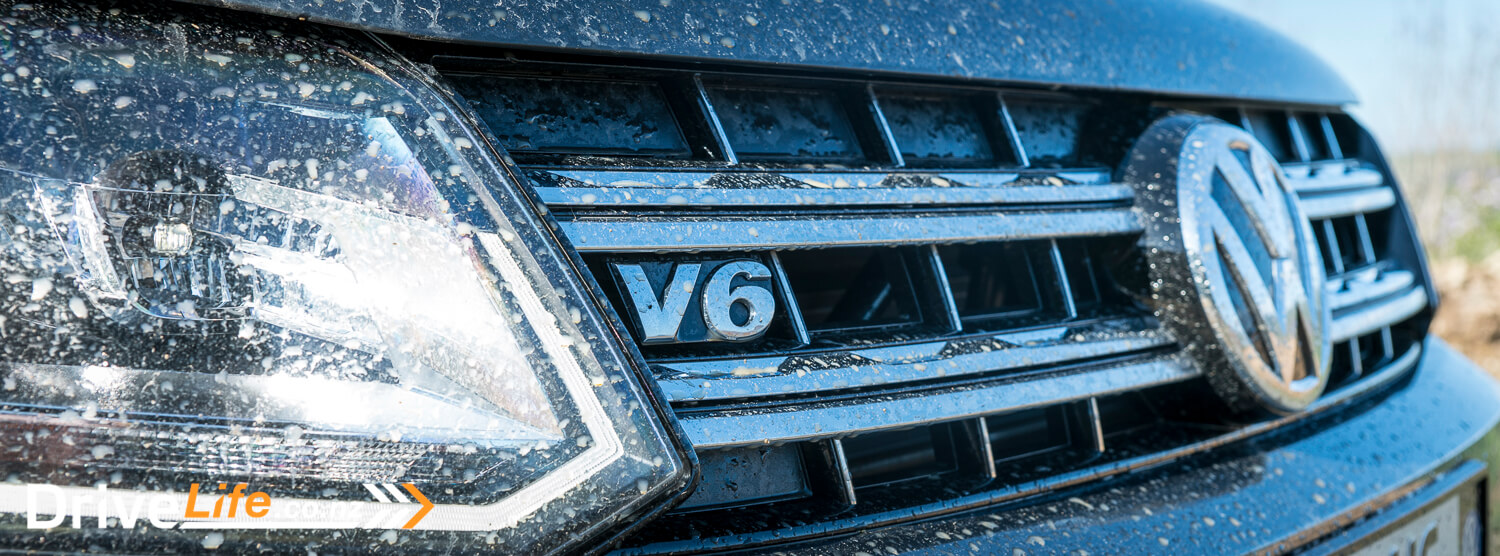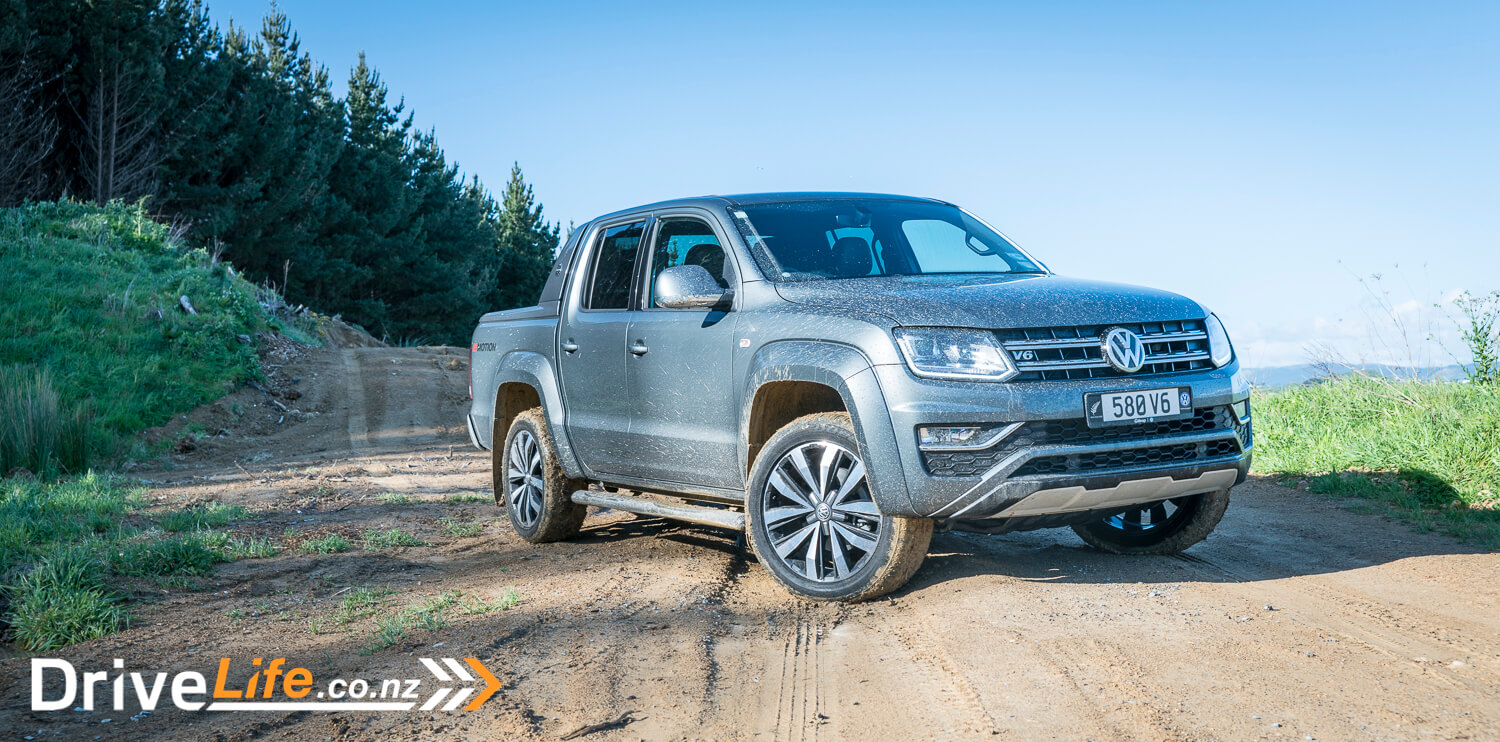In May of this year we got the opportunity to test the 2017 VW Amarok V6 Highline on a 1,500 km road test from Wellington to Dunedin and back again. We loved the V6 Amarok, how it drove, felt and towed like a freight train.
So you can imagine our surprise and excitement when we heard that there was a new, more powerful V6 TDi on the way.
The standard V6 TDi produced 165kW and 550Nm, which is not exactly underpowered. The new V6 TDi for the top spec Aventura produces 190kW and 580Nm of torque. Awesome, we couldn’t wait to review it.
What’s In The 2018 VW Amarok Range?
The Amarok range is pretty big, with 8 model variants available. It starts with the 4WD Core TDi ($50,900), 4WD Single cab TDI ($57,990),4WD Comfortline TDi ($58,990), 4WD Sportline TDi ($65,990), 4WD Highline TDI ($65,990). The V6 range now comes in 4 models, the Amarok V6 550Nm ($69,990) the Amarok V6 550 Nm Highline ($78,990) the Amarok V6 550Nm Aventura ($85,990) and finally the new Amarok V6 580Nm Aventura ($89,990).
Only the Core and V6 Highline are available in manual and automatic. Both manuals have selectable 4Motion four-wheel drive, while the automatics have permanent 4Motion four-wheel drive.
There are now 3 engine options across the entire range. The 2.0-litre twin-turbo four-cylinder diesel and two 3.0-litre V6 turbo diesel variants. The 2.0-litre TDI delivers 132kW of power and 400Nm of torque, not bad for a 2.0-litre. The standard 3.0-litre V6 TDI delivers 165kW and 550Nm of torque. It also comes with an overboost option which gives the engine an additional 15kW of power while extending the maximum torque delivery for up to 10 seconds. The second V6 is only available on the top spec Aventura and is the same 3.0-litre V6 TDI which now delivers 190kW and 580Nm of torque. It also comes with an overboost option which gives the engine an additional 10kW of power while extending the maximum torque delivery for up to 10 seconds.
All automatic models come with the permanent 4Motion four-wheel drive. The Manual 4WD Core model comes with selectable 4Motion. The 4Motion four-wheel drive system can distribute between the front and rear axles 40:60. When driving on loose surfaces the self-locking Torsen differential automatically distributes power to the driven wheels with the most traction.
All Amaroks have two optional spring load systems. The heavy-duty 3+2 leaf spring and a 2+1 leaf spring. The 2+1 spring allows for an increased tow limit of 3500kg while the 3+2 spring has a tow limit of 3200kg. The 2+1 spring also reduces the GVM and payload for the cargo area which is 1010 kg compared to the 1041 kg on the 3+2 spring. Either can be selected for any Amarok as a no-cost option.
The V6 Amarok Aventura comes with a raft of standard options. 20” Talca Alloy Wheels, dual- zone climate control, cruise control, premium multi-function display, BiXenon headlights with daytime running lights. You also get auto lights, auto wipers, paddle shift gears, park distance control front and rear with rear view camera, front side windows in heat insulating glass and privacy glass for rear windows, towbar preparation, Chrome Styling Bar or Moulded Sports Bar & Stainless Steel Side Bars, Durabed tray liner and 14-way leather seats.
As for additional options, you can select a mechanical differential lock on the rear axle, roll cover, matte body paint, floor covering – robust rubber, paddle shift levers and seat covering – ‘Vienna’ leather upholstery in Palladium Black.
First Impressions Of The 2018 VW Amarok V6 Aventura TDI
Much like the previous review of the V6 Highline, I was secretly hoping that our test vehicle would be Ravenna Blue Metallic, which is only available on the Aventura. Yet again, no such luck, it was Indium Grey Metallic. It was an improvement over silver, but nothing exciting. The Amarok Aventura has a slightly different look over the standard model – This model get a sports bar-like panel that extends the visual look of the cabin and flows down the top of the tray with additional trim panels. I like it, probably not as useful as a real sports bar, but it does complement the look of the more adventurous model. You also get stainless steel side bars, and 20” Talca Alloy Wheels only available on the Aventura.
Unlike the Highline, the Aventura spec has an obvious visual change over all the other models, making it feel a bit special. This vehicle had been spec’d with the roller cover and the deck had been lined with the Durabed tray liner. The finish to the inside of the deck was very nice factory finish, unlike some other manufacturers’ third-party tough-deck accessories.
I do prefer this look for the Amarok, it sets it apart while still having that strong and modern presence.
What’s The Interior Like On A 2018 VW Amarok V6 Aventura TDI?
The inside of the Amarok V6 Aventura has been upgraded with leather sports seats, probably from the Golf or similar R-Line VW range. The seats, steering wheel and gear shift surround all have highlights stitching making it feel like a premium product. The rest of the interior follows the same theme as the Highline. This was great and it really helped to make the Amarok more like an every day family vehicle than a commercial ute. Even though the Aventura is $7K more than the Highline, there is a feeling that you’re getting more value for money in this price bracket.
More on those seats, fully electric too, I was impressed. I always prefer a seat with good side support, which you tend to get with leather seats and the material is tougher, holding the seat foam in position. The seats are comfy, supportive and great for long trips. Good height too, so your legs never felt too cramped.
The cabin itself was pretty clean, some buttons around the gearstick, media screen and an array of 12-volt plug sockets – two beside the gear stick, one on the dash and another for the rear seat passengers. This would be great for long trips, as you didn’t have to share the plugs and could charge all sorts of devices at the same time.
The centre-console media screen was the main focus in the cabin and probably the most high tech bit of equipment too. It’s the same tried and trusted system used in all of the VW passenger models, and was super easy to use for paring phone and setting up the nav system. I did feel like it was a bit on the small side, the screen and the surrounding buttons that is. And I say that only because ute drivers sometimes find themselves wearing gloves, and small buttons don’t work well with gloves.
The steering wheel was another feature from the VW passenger line up. This has the usual volume, phone, cruise control and menu options you would expect to see at this price. Unlike the Highline the Aventura comes with paddle shift on the steering wheel. I really don’t see the need for paddle shifters with an 8-speed auto gearbox. Even though the V6 TDi is powerful, it’s not sporty, and I found no real benefit to using the paddles over the standard auto gearbox.
VW are proudly advertising the Amarok as having the largest tray in its class, offering 2.52 square metre and 1.222mm between the wheel arches. This allows you to load a pallet onto the deck. I was actually surprised that this is not possible in all utes. The rear deck-load capacity is 1,010kg, and has a tailgate that can cope with up to 250kg. Our test model came with a ROC retractable hard lid from RVE and Durabed tray liner. The deck cover rolled back up into its own sealed box, which had two drainage holes that were connected into the front of the deck, presumably into existing drainage holes. I was dubious about how well it would work in the rain, but after the torrential rain we had in Wellington after arriving back from our trip, I now have 100% faith in this cover. I did find when testing the Aventura that the box for the tray does take up a bit of room, when you’re trying to carry planks of wood. Not the end of the world, but it did start to get in the way.
Sadly there was no push-button start and keyless entry on the Aventura not even an optional extra. I was really surprised at this, as there are lots of vehicles at even half the price of the Amarok that have these features as standard. Come on VW, sort it out and at least offer it as an option.
Cabin storage was ok, some space in the centre console, large pockets in the doors, and a recessed tray in the middle of the dash. Plenty of spaces to put things, but not many spaces to put things out of sight. I am not sure if this is a big problem or not, but it was something that bothered me. Yes you could use the glove box, but it wasn’t large by any means.
In the rear of the cabin, there are three seats with a 60/40 split in the middle. The space in here was pretty good, even with the driver’s seat set for a tall person. It was not cramped or uncomfortable. I did find that when we put our baby seat in the back, it had to be set up in an upright position, which would be an issue for newborns if this is your only vehicle. The passenger seat has to go really far forward to make enough room for the baby seat to recline.
The split allowed you to fold up the seats for extra storage space. This didn’t work as well as other utes, as the floor was not flat when the seats were up, so you still have an awkward space to deal with. If the floor had been flat under the seats and footwells, it would have created a decent amount of practical space. The ties used to hold the seats up were also a bit of an afterthought and no more than bungee cords. This seems a bit crude and not great for the nice seats and materials they were holding up.
What Does The 2018 VW Amarok V6 Aventura TDI 580Nm Drive Like?
You can tell that this is not as commercial as other utes, the interior is comfy and refined. Which also extended to the driving experience, the ride was firm and that engine was no louder than a diesel car or SUV. Many utes have stiffer suspension to cope with any big loads that may be carried in the rear. I did notice that the change from 19-inch wheels in the High Line to 20-inch in the Aventura made some aspects of the ride a bit bumpy, noticeable only when the tray was empty on poorly maintained roads. The low-profile tyres must have less give in them when there is no weight in the deck. But in saying that it never woke my daughter when she was asleep, so it can’t be that bad.
You can’t help but feel comfortable in the Amarok – it’s not like other utes. My wife has a VW Golf, so there were many aspects that have been migrated across to the ute platform. Any previous or existing VW owners should feel right at home inside any of the Amarok models. It felt more like a tall car or SUV.
The body roll was not as extreme as some other utes. It was not a boat to drive, actually it was rather sharp. In some utes the combination of soft suspension and soft seats result in you holding on to the wheel to stay in your seat as you go around a corner. Not in the Amarok, it was so well planted that you just drove it like you would any other car. This was great for such a big truck, as it gave me the great confidence of driving a car even if you were not used to driving a ute.
The power from that 3.0-litre V6 was impressive, that 580Nm came on like a freight train, with no sign of the power band letting off. It does sound like a lot of torque, which it is, but it was easy to control how much you needed. Even though it’s a diesel engine the sound from it is powerful and intoxicating. You feel confident and in control from behind the wheel, with enough power to tackle everyday and not so everyday tasks at the same time.
From the driver’s seat you have a commanding view, with not much obstruction when looking around. The rear view mirrors are great – a perfect size to give you a clear view down and out into the lane beside you. The Aventura comes standard with park distance control in front and rear with rear view camera system. The parking sensors were excellent and very helpful to gauge where the front of the truck was, due to its sloping bonnet and flat front design.
The rear view camera was ok, good clarity but its position on the rear was rather low. The camera had been positioned just under the tailgate and above the licence plate. I can see why it’s there, but I am not sure if it’s the best position for the end user. Where it’s positioned allowed easy visibility to the tow bar when trying to line up a trailer. The downside of this was that the tow bar always took up a decent part of the image. It also allowed you to use it when the tailgate was down. Not sure this would be used a lot, as it was hard to see where the corners of the truck were. I would have prefered if they stayed with the hidden camera behind the VW logo, as in most cases it’s the perfect height and angle to use with wide angle rear view cameras.
The other issue I had with the camera or actually the display was the parking sensor image overlaid on the left-hand side of the rear view camera display. I found this a bit annoying as it made it hard to see when reversing out of parking spaces. I found that I have to look over my shoulder on the right instead of using the camera. I was unable to find an option to turn this off – it may be there, but I couldn’t see it.
The small amount of offroading I did while driving the Amarok was a bit different to what I am used too. Instead of the usual 4-Hi and 4-Lo gears settings, its all handled automatically with the 4MOTION four-wheel drive and Torsen differential. Combine this with an Off-road ABS which is a simple button by the gear stick, the braking interval is increased; the wheels lock up in a controlled manner so the material from the ground, builds up onfront of each wheel reducing the stopping distance. So much tech it was hard not to be impressed, but at the same time, I never know what was happen and when unlike some of the manual system. Overall it handled everything I throw at it, never having a single issue.
The new V6 is still a beast, we never really noticed the addition of a trailer when testing the Highline. Add more 30 more Nm and you won’t feel much back there when towing. It’s got to be one of the toughest trucks available for heavy towing.
What’s The Competition For The 2018 VW Amarok V6 Aventura TDI 580Nm?
What may have seemed like a novelty market years ago is quickly growing into the latest trend as these utes become easier to live with on the day-to-day. The Amarok is the most expensive in the group, with only one other V6 ute to choose from.
| Brand/Model | Engine | Power/ Torque |
Fuel, L/100km | Seats | Deck Load, Kg | Towing Capacity, Kg |
Price |
| VW Amarok V6 Aventura | 3.0L V6 twin turbo diesel | 190kW/ 580Nm | 7.8 | 5 | 1010 | 3500 | $89,990 |
| Ford Ranger Wildtrak | 3.2L V6 TDCi | 147kW/ 470Nm | 8.9 | 5 | 950 | 3500 | $75,990 |
| Mercedes-Benz X 250d Power 4WD | 2.2L i4 Twin Turbo | 140kW/ 450Nm | 7.9 | 5 | 1000 | 3500 | $69,000 |
| Holden Colorado 4X4 Z71 | 2.8L i4 TD | 147kW/ 440Nm | 11.9 | 5 | 825 | 3500 | $66,990 |
| Mitsubishi Triton 4WD VRX Diesel | 2.4L MIVEC TD | 135kW/ 437Nm | 7.6 | 5 | 955 | 3500 | $62,990 |
| Nissan Navara ST-X Warrior 4WD | 2.3L Twin Turbo Diesel | 140kW/ 450Nm | 7.0 | 5 | 800 | 3500 | $61,990 |
| Mazda BT-50 Double Cab 4WD Limited | 3.2L i5 DOHC TD | 147kW/ 470Nm | 10 | 5 | 950 | 3500 | $59,795 |
| Toyota Hilux 4WD SR5 | 2.8L i4 TD | 130kW/ 450Nm | 8.5 | 5 | 1000 | 3500 | $56,990 |
What’s The Pros And Cons For The 2018 VW Amarok V6 Aventura TDI 580Nm?
| Pros | Cons |
|
|
What Do We Think Of The 2018 VW Amarok V6 Aventura TDI 580Nm?
It was great to be back in the V6 Amarok, and to see how different it was to the Highline. I did find the larger 20-inch wheels made aspects of the ride a bit bumpy, over the 19-inch wheels on the Highline. This was only noticeable when the tray was empty.
Overall the Amarok is still a bit of a beast, and with the extra power available in the top spec Aventura, I can’t imagine you will even notice the drain on power, even if you’re pulling a 3.5-ton boat.
It’s a commercial machine that has everything you want from the standard family range, looks good and stands out from the crowd. But this all comes at a high price compared to what’s available on the market.
Rating – Chevron rating (4 out of 5)
2018 VW Amarok V6 Aventura TDI 580Nm – Specifications
| Vehicle Type | High End Commercial Ute |
| Starting Price | $85,990 plus on-road costs |
| Tested Price | $85,990 plus on-road costs (factory options only) |
| Engine | 3.0-litre Turbo Diesel Injection V6 |
| Power Kw / Torque Nm | 190kW/580Nm |
| Transmission | 8-speed automatic transmission |
| 0 – 100 kph, seconds | 7.3 |
| Spare Wheel | Full-size light alloy spare wheel |
| Kerb Weight, Kg | 2070 |
| Length x Width x Height, mm | 5254x2228x1834 |
| Tray Payload kg | 1010 |
| Fuel Tank, litres | 80 |
| Fuel Efficiency | Advertised Spec – Combined – 7.8L / 100km Real World Test – Combined – 9.2L / 100km Low Usage: 0-6 / Medium Usage 6-12 / High Usage 12+ |
| Towing | 3500 kg braked |
| Turning circle | 12.95 m Small: 6-10m / Medium 10-12m / Large 12m+ |
| Warranty | 3 year / 100,000 km mechanical warranty 6 year anti-corrosion warranty 3 year Volkswagen Roadside Assistance |
| ANCAP Rating | 5 Star |


